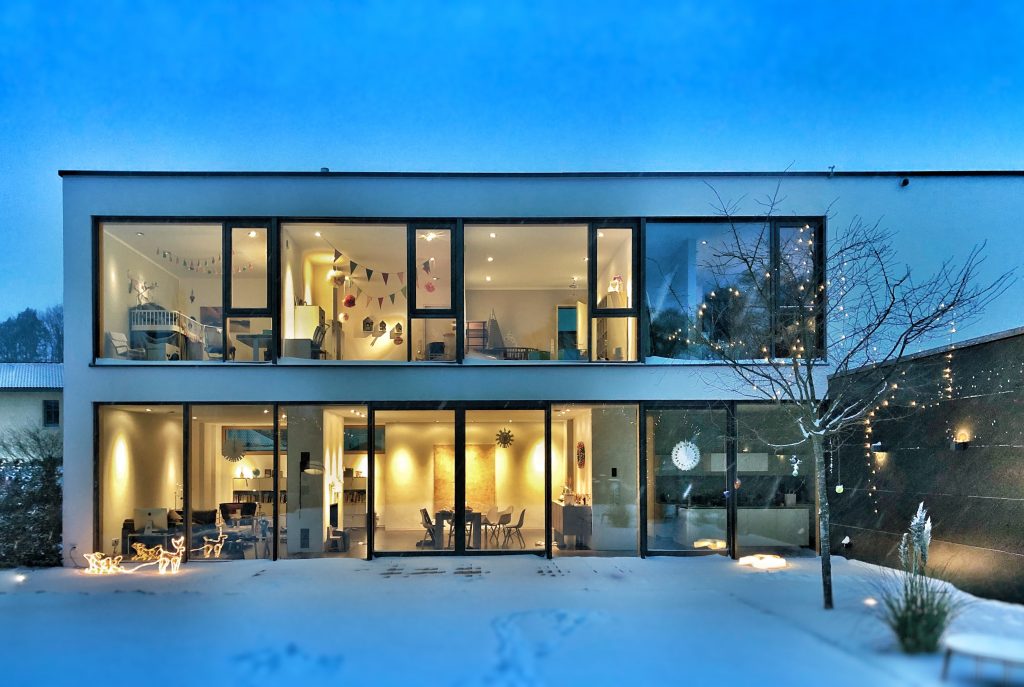1. Look for air leaks
Since heating in the winter accounts for more than half of your electricity bill, it is important to make sure of its efficiency. Many households spend a large quantity of energy to compensate for lacking insulation. How to know if this is the case for your home? Some indicators can help you figure out if you have air leakage: electricity bill increases in the early fall, temperature is fluctuating from room to room, walls and floors are cold in certain areas, fog is forming on some windows, a cold breeze is felt next to your doors or windows. You can also do the candle test, which consists of slowly moving a lit candle around the junctions between your walls and windows. If the flame moves, you can consider air leakage at the spot.
If you recognize some of these symptoms in your house, go to the problem’s source and try to locate where the leaks are.
2. Insulate your home
Now that you have located the places where your heated air is leaking, you can now take action and insulate your home. According to many sources, insulation is one of the most cost-efficient ways to manage your energy consumption.
One of the cheapest techniques is to caulk your windows and doors to make them more airtight. For windows, you can get a caulking gun as well as a high quality caulking paste, and apply the paste around the frames, according to the instructions on the product. As for doors, get weatherstripping, which is a plastic or foam device that impedes hot air from escaping.
There are other places from where the hot air could be leaking that you might want to consider: fireplace, washer/dryer wall entrance, electrical outlets, etc.
3. Reduce your hot water consumption
Hot water can consist of 20% of your whole energy consumption, second placed after heating.
It is possible to adopt better hot water consumption habits, and even though they might seem obvious, it never hurts to refresh our memory:
- Washing your clothes in cold water (and invest in a cold water detergent)
- Shutting off the tap and shower when the water is not being used (when brushing your teeth, washing the dishes, washing your hair, etc.)
- Reduce your shower time of 1 minute (it can make a difference!)
- Repair water leaks (faucets or shower heads that drip)
- Surround your water heater with insulating products
- Change your shower head for an eco energetic one, that limits the water flow.

4. Regulate your heating system
As mentioned earlier, heating is the element on your energy bill that is the most costly. By regulating your heating habits, there are good chances that you’ll be able to attain considerable results in terms of profitability.
Regulating your heating energy consumption is simple: it is about strategically controlling the moments and rooms, and when and where the heating is on. For example, lowering the heating by 50% if you are leaving for the weekend, reducing the heating only by a couple of degrees during the night, lowering the heat in unoccupied rooms, etc. It is also recommended to change your thermostats for smart or electronic thermostats, some of which you can program according to a fixed schedule and save without even doing anything.
5. Unplug inactive devices
Also called “ghost charges”, costs associated with providing energy to turned off devices represent approximately 40% of your yearly bill. Even when unused, household appliances that are connected to a source of electricity are still consuming a surprising volume of energy. Here are some tricks to avoid being charged for inactive devices:
- Disconnect the devices that you only use a few times: TV monitor, coffee maker, video game console, printer, decoder, etc.
- Stop charging your smartphone and computer once they are fully charged
- Connect your electronic devices to a multi-socket extension or power strip, and turn them all off at the same time.
6. Improve your lighting
Without even knowing it, you could be contributing to increasing the cost of your electricity bill by the way you use your lights. Multiple factors should be considered in relation to lighting and energy consumption. Choosing the right light bulb is one, and can help you save a lot of money. Halogen bulbs, very common across Canada, are consuming 70% to 90% more energy than LED light bulbs. You can also get a lighting dimmer, which allows you to diminish the lightbulb’s intensity.
Other habits can be considered to improve your lighting, such as turning off the lights during the day in rooms that are naturally lit by daylight, or using smaller lamps instead of the main luminaire, and even to go for a smart lighting system programmed to turn off the lights automatically when no movements are detected after a certain time.
7. Download an energy-tracking app
To really be able to reduce your energy consumption and bills, you might want to know about your current usage data and in order to adjust in the future. There are many apps on the market today that are designed to track your energy usage, and allow you to monitor your own habits based on real-time data and history. Depending on the app, some will provide you with tracking sheets and diagrams of your electricity usage and cost per day, week, month and year, from which you can base yourself on to set goals for future months.
Some “smart” apps that are connected to smart products in your home, such as lighting, electrical outlets or thermostats, provide you with full control of your devices, as well as monitoring options according to your needs. For example, by connecting your lighting system and your thermostats to your energy tracking app, you could turn off the lights remotely, and set the thermostats to automatically lower the temperature each night at 9 p.m.
8. Invest in smart devices
Smart home technologies are strongly oriented towards energy efficiency and optimization, to allow a more sustainable energy consumption. This being said, a lot of devices on the market have been specifically designed to reduce costs related to electricity usage, as well as allowing to control, program and adjust remotely via your smartphone.
Many smart products are available to help you build your energy-efficient smart home:
- Smart Heating
- Smart Light Bulbs
- Smart Plugs
- Smart thermostats
- Smart dimmers
For most of these devices, you simply have to connect them to the Wi-Fi and to your mobile app.
A smart thermostat helps regulate temperature throughout the day and night to reduce energy consumption and costs. TELUS SmartEnergy is an energy management solution that provides convenient control of your smart thermostats and smart plugs in one easy-to-use app, helping you lower your household budget through energy savings.
Monitor and optimize your home’s energy use, identify consumption habits, automate energy-saving actions for your connected devices, and earn rewards by participating in energy-saving events.
9. Check your pool or hot tub’s consumption
Costs related to the maintenance of your pool or hot tub could be responsible for up to 70$ of your electricity bill during the summer months. You might want to double-check your maintenance habits, which might cost you a lot in the long run.
It is also advised, to save on energy costs due to your pool, to use a solar blanket, which warms up the water of the pool and maintains the temperature, and reduce the need for a heating system. Using a heat pump and a timer are also considered to optimize your energy consumption.
As for hot tubs, it is recommended to put it in a spot hidden from the wind and snow. Also, make sure to close the top immediately after each use, and to set the temperature in “sleep mode” in between uses.
10. Use your appliances wisely
Household appliances are part of our lives, and even if they promise to be ecological, the way we use them also counts for a lot.
For instance, we can find many dishwashers on the market that are labelled as “green”, and limit the volume of water used for every cycle. However, it is important to only use the dishwasher when it is completely full. Also, the water-saving quality of the dishwasher is worthless if, for example, the dishes are washed by hand beforehand.
As for laundry, if you do not have an energy-efficient washing machine or dryer, it is still possible to have good habits and lower the cost of your overall electricity bill. For example, using cold water instead of hot when doing your laundry can reduce your consumption by a lot. It is also recommended that the washing machine is only used for big loads, and, if possible, to dry out your clothes with the dryer only 1 times out of 2.
11. Think big!
If you want to truly commit to a more sustainable lifestyle, and maintain a long-term low energy consumption, there are some bigger scale solutions available.
You could, for example, invest in the installation of solar panels, a heating system that is more and more popular in the United States and Canada. If your home is compliant to using this natural renewable energy, you could save a lot of money on your energy bills!
Another method that allows the reduction of electricity consumption is to plant big trees around the house. Not only can trees reduce air-conditioning costs by 30%, they also prevent hot air from leaking out during the winter months.





